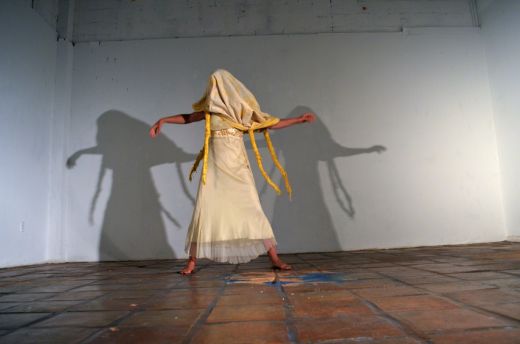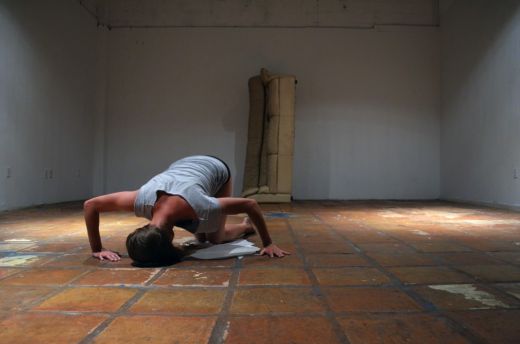Miami Performance International Festival
Eddie Arroyo

Maria Theresa Barbist, Kreatur, 2014. Performance View. Photo courtesy of the author.
Botanical Gardens in Miami Beach and The Design District
June 14-29, 2014
Held in the city’s dormant summer months since 2012, The Miami Performance International Festival offers artists from the States, Latin America, the Caribbean, and Europe a public platform far from Art Basel. Organized by artist and curator Charo Oquet the festival is unrefined compared to market-driven fairs, allowing artists to express challenging themes that emphasize the pressures of conformity and emotional states of being.
With an approach to mourning in mind and a pair of scissors at hand, Polish artist Krzysztof Andrzej Dziemaszkiewicz announced the recent death of his mother and then cut the three-piece suit he wore to shreds. Completely nude he then proceeded to pour honey over his body, got on his knees, emptied a plastic garbage bag full of black earth onto the floor and began to writhe in it, crawling and twisting into the soil for a number of minutes while he whimpered. Descending further into a primal state he reached for a piece of rope, tied his upper leg to his shin and pathetically crawled out the door. Bringing the audience outside of comfort was the overall tone not only of Dziemaszkiewicz’s effort, but of many other performances as well.

Anna Steller’s Transportation. Photo courtesy of the author.
Standing against the wall in her underwear and with a sheet of paper, Polish artist Anna Steller began to yell incomprehensible words in frustration. Unsatisfied with being heard and with an excessive need to convey power, she propelled her body into a used couch and repeated the action across the interior of the space. Then gradually she lifted the couch to its side and carefully climbed the domestic monolith; after standing atop for a minute she leaped off onto the concrete floor on her bare feet. Steller concluded the performance by pushing her head through a puddle of white paint and gradually stripping nude. The piece,“Transformation,” was visceral but excessive; it might have been stronger if one sequence of actions were the main focus, as to not sacrifice the overall narrative.
Austrian artist Maria Theresa Barbist’s “Kreatur” performance was quieter by comparison and seemed latent in traumatic lore. She stood in a wedding dress and began jumping lightly in place, then stopped declaring, “I am the maker!” Crouching, she would approach an object on the wall whispering, “Who are you?” with subtle and disturbing dialogue. Barbist held a fabricated shape made of cloth and placed it over her head so that it consumed her in distress. She would pull it back and forth as her head and body moved along with it. Finally she discarded the cloth, looked down at it, and walked away.
The performances weren’t all about exploring personal narratives, but rather the raw energies on display. Presented in an unpolished platform combined with the absence of sleek fair packaging, 2014’s Performance International Festival was a welcome change from the city’s winter months.










